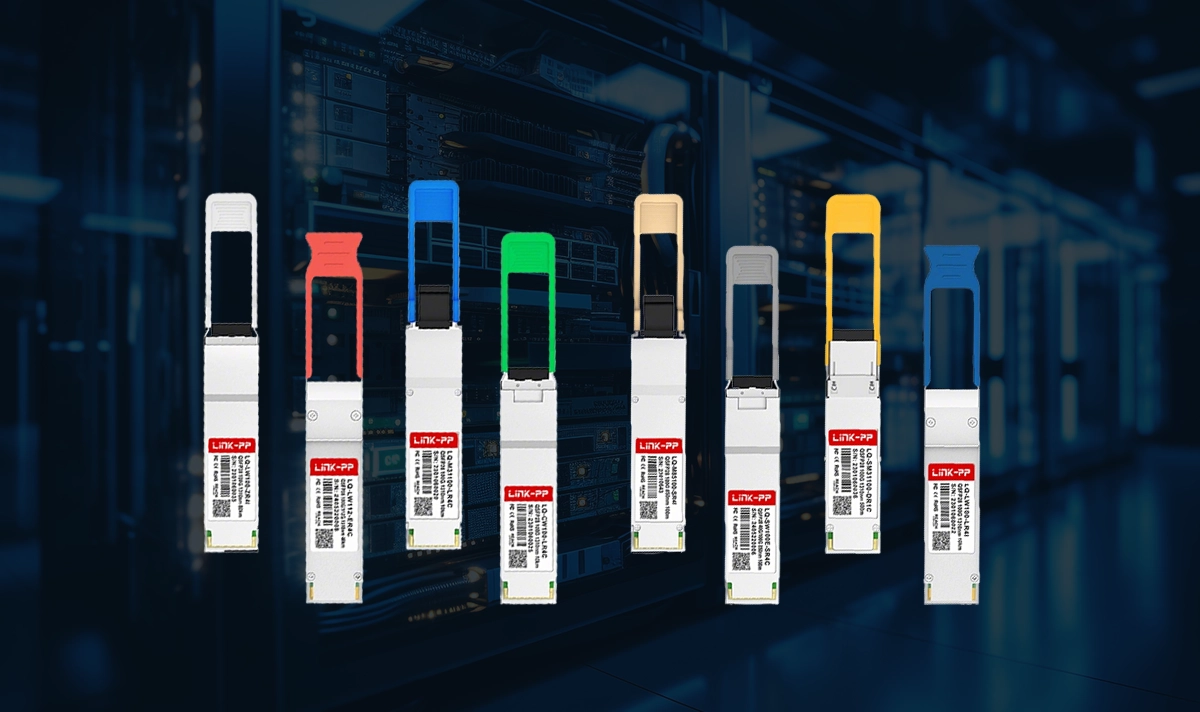
As bandwidth demands explode, 100G QSFP28 modules have become the backbone of modern data centers and 5G networks. But traditional dual-fiber solutions require twice the fiber cabling, escalating costs and complexity. Enter single fiber QSFP28 modules—a game-changer using BiDi (Bidirectional) technology to transmit 100G data over one fiber strand. By leveraging different wavelengths (e.g., 1271nm/1331nm) for upstream/downstream traffic, these modules cut fiber infrastructure costs by 50% while maintaining full 100G performance.
➤ How Does 100G Single Fiber Transceiver Work? (The BiDi Principle)
Unlike standard duplex transceivers requiring two fibers (one Tx, one Rx), single fiber modules use Wavelength Division Multiplexing (WDM). They employ two different wavelengths (colors) of light:
Transmit (Tx): Sends data using one specific wavelength (e.g., 1271nm).
Receive (Rx): Listens for incoming data on a different wavelength (e.g., 1331nm).
A special filter (WDM coupler) inside the module combines and separates these signals onto the single fiber strand. This Bi-Directional (BiDi) communication is the core innovation.
➤ Why Choose 100G Single Fiber Modules? Key Advantages:
Double Your Fiber Capacity: Maximize ROI on existing single mode fiber plant. Avoid costly new fiber runs.
Significant Space Savings: Reduce fiber cabling density in racks and conduits. Crucial for high-density data centers and space-constrained deployments.
Cost Reduction: Lower costs associated with fiber purchase, installation, and management.
Simplified Network Design & Management: Easier cable management and reduced points of failure.
Future-Proofing: Efficiently scale bandwidth without constant physical infrastructure upgrades. Ideal for enterprise networks, 5G fronthaul, and FTTx applications.
➤ 100G Single Fiber vs. Traditional Duplex: A Clear Comparison
Feature | 100G Single Fiber (BiDi) Module | Traditional 100G Duplex Module |
|---|---|---|
Transmission Type | Bi-Directional (BiDi) | Duplex |
Fiber Count | 1 Strand (per link) | 2 Strands (per link) |
Technology | WDM (Two Wavelengths) | Single Wavelength per Fiber |
Fiber Utilization | Highly Efficient (2x) | Standard |
Ideal For | Fiber Exhaust, Space Constraints | New Builds, Ample Fiber |
Installation Cost | Lower (Uses Existing Fiber) | Higher (Requires More Fiber) |
Cable Density | Reduced | Higher |
➤ Unlock Peak Performance with LINK-PP 100G Single Fiber Solutions

LINK-PP, a leader in innovative optical connectivity, offers a robust portfolio of high-quality, reliable 100G single fiber transceivers designed for demanding applications. Our modules strictly adhere to MSA standards (QSFP28 form factor) and support various transmission distances.
Featured LINK-PP 100G Single Fiber Transceivers:
LINK-PP LQ-BL8591100-SRC: Perfect for cost-effective 100G links over up to 100 meters on multi-mode fiber (MMF). Ideal for intra-data center connections and enterprise backbones needing budget-friendly single strand fiber solutions.
LINK-PP LQ-BLA(B)100-LR1C: The workhorse for longer reach 100G single fiber applications, delivering up to 10km. Essential for metro network aggregation, campus links, and 5G midhaul deployments requiring single fiber connectivity. (*Wavelengths: 1271nm / 1331nm)
LINK-PP LQ-BLA(B)100-ER1C: Conquer extended reach single fiber challenges with up to 40km transmission. The go-to choice for long-haul 100G single strand connectivity in regional networks and challenging infrastructure. (*Wavelengths: 1304nm / 1309nm)
➤ Choosing the Right 100G Single Fiber Module: Key Considerations
Required Distance: Match the module's reach (SR, LR, ER, ZR) to your link length.
Fiber Type: Ensure compatibility with your existing single mode fiber (SMF).
Wavelength Pair: Modules must use complementary wavelengths at each end (e.g., 1271nm/1331nm paired with 1331nm/1271nm). LINK-PP offers matched pairs.
Compatibility: Verify compatibility with your specific switch, router, or media converter.
DDM/DOM Support: Digital Diagnostics Monitoring (DDM) is crucial for real-time performance tracking and troubleshooting in data center environments.
➤ Conclusion
100G single fiber transceivers are no longer niche; they are a strategic necessity for optimizing fiber resources, reducing costs, and enabling scalable high-speed networks. Whether you're battling fiber exhaust, designing a high-density data center, or deploying 5G transport, single strand fiber technology offers a powerful, efficient solution.
Ready to leverage the power of single fiber for your 100G needs?
➡️ Contact our optical experts for a personalized recommendation!
Upgrade smarter, not harder. Choose LINK-PP for your single fiber advantage. ✨
➤ FAQ
What is a 100G single fiber QSFP28 module?
A 100G single fiber QSFP28 module sends 100-gigabit Ethernet data using one optical fiber. This device helps networks get faster without needing extra fiber cables.
What benefits do 100G single fiber solutions bring to networks?
These solutions save room and cost less money. They let networks use old fiber lines for faster speeds. Operators can add more devices and make networks bigger with little trouble.
What types of networks use 100G single fiber technology?
Data centers, enterprise backbones, and metro networks use this technology. These networks need fast connections and steady work every day.
What makes QSFP28 modules important for modern networks?
QSFP28 modules give high density and use less power. They fit in regular equipment and help networks grow. These modules make upgrades quick in busy places.
What should operators check before adding 100G single fiber modules to networks?
Operators should check if the device and fiber type match. They need to make sure the modules fit the network gear. This helps networks avoid problems with connections.




